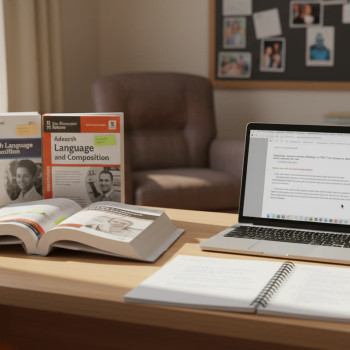Why Highlighting Often Hurts More Than It Helps (and Why We Keep Doing It)
If you’re like most AP students, you’ve seen a textbook page turn into a neon Jackson Pollock: yellow, pink, green—an emotional memorial to a study session that felt productive. Highlighting is seductive. It’s visible progress, portable, and satisfying. But too often it becomes a map of surface-level attention, not deep understanding. Instead of clarifying the skeleton of an argument, it amplifies noise.
Here’s the hard but helpful truth: highlighting by itself is passive. Students highlight entire paragraphs, then assume the important stuff will magically stick. It rarely does. The better move is to let highlighting be one tool among many—used selectively and intentionally—so your notes, memory, and exam responses actually improve.
A Simple Framework: PREP—Preview, Read, Evaluate, Pinpoint
Before your highlighter even leaves the cap, try this four-step habit. PREP keeps your mind scanning for meaning, not color.
- Preview: Scan headings, subheadings, opening and closing sentences, charts, and any bolded words. This gives you the scaffolding for comprehension.
- Read: Read once for meaning with no highlighter. Ask: What is the author’s main point? What’s the evidence?
- Evaluate: Decide if the sentence or phrase is central to the author’s point or just an illustration, example, or filler.
- Pinpoint: Highlight only the most essential words or phrases—keywords, definitions, thesis sentences, and transition cues—then add a quick margin cue.
This approach slows you down in a disciplined way. It converts highlighting from a reflexive action into a decision with criteria.
What to Highlight (Really): The Minimalist Checklist
Treat your highlighter like a scalpel, not a paint roller. Highlighting is best when it forces you to distill a sentence down to its most meaningful kernel. Use this checklist to decide what qualifies:
- Definitions and precise vocabulary you must recall.
- Author’s thesis or topic sentence of a paragraph.
- Key evidence, data points, or dates for history and science.
- Transition phrases that show argument structure (however, therefore, moreover).
- Formulas or step patterns in math and science—one line that summarizes the method.
- Short illustrative examples that clarify a concept (but only the essential phrase, not the whole paragraph).
If a line takes more than 10–12 words to capture the idea, consider writing a one-line margin note instead of highlighting the whole thing.
How to Highlight for Different AP Subjects
Not all AP courses ask for the same kind of remembering. Tailor your highlighting style to the thinking the exam demands.
AP English Language and Composition
Highlight the rhetorical moves: claims, evidence, tone shifts, and key diction. Instead of highlighting entire examples, underline the device and jot a margin tag like “Ethos” or “Counter-arg.” Practice turning highlighted phrases into one-sentence summaries that you can recite.
AP United States History / AP World History
Dates, cause-and-effect statements, and the author’s argument deserve attention. For primary sources, highlight the speaker, audience, purpose, and one or two phrases that show perspective. For secondary sources, capture thesis statements and three supporting points at most.
AP Biology / AP Chemistry / AP Physics
Highlight formulas, units, and the conditions that change an equation’s application. Mark step-by-step procedures in experiments (but condense into your own shorthand in the margin). For conceptual passages, highlight the cause-effect link and jot an arrow to a diagram if needed.
AP Calculus / AP Statistics
Highlight the final results and the key step that justifies them (e.g., substitution step, limit setup, or distribution assumption). Avoid highlighting every number—focus on the conceptual move.
Active Highlighting Techniques That Boost Understanding
Want your highlighting to work for you? Combine it with active, retrieval-friendly habits.
- One-Line Margin Notes: Directly next to a highlighted bit, write a 3–6 word summary or a question. This converts passive markup into cognitive prompts.
- Color with Purpose: Use colors sparingly and consistently—one color for thesis/claims, one for evidence, one for vocabulary. But no more than three colors per resource—color chaos defeats memory.
- Highlight Then Cover: After highlighting, cover the page and try to recall the highlighted kernels aloud. If you can’t, refine your highlights or the margin note.
- Transform Highlights into Flash Prompts: Convert highlighted phrases into Q&A pairs for spaced repetition—especially useful for APUSH timelines or Biology terms.
A Study Table You Can Copy: Weekly Plan That Uses Highlighted Notes Well
Below is a sample weekly plan that leverages careful highlighting alongside active review. Use it as a template and tweak for your AP subject and exam date.
| Day | Focus | Action Steps | Time |
|---|---|---|---|
| Monday | New Unit Preview | Preview chapter, read once, PREP, highlight kernel phrases, create 5 margin Qs | 60–90 min |
| Tuesday | Active Recall | Cover page, recite highlighted points, make flash cards, 1 practice problem | 45–60 min |
| Wednesday | Application | Do 2–3 free-response or multiple-choice questions using highlighted notes only | 60 min |
| Thursday | Deepen Understanding | Re-read difficult passages, add margin comments, refine highlights | 45–75 min |
| Friday | Synthesis | Create one-page summary from highlights; practice explaining to a friend | 60 min |
| Weekend | Spaced Review | Use flash cards, timed practice set, make small adjustments to highlights | 90–120 min total |
Examples: From Messy Highlighting to Helpful Highlights
Let’s walk through a few quick before-and-after examples so the idea lands.
- AP English (passage): Before: highlighted whole paragraph. After: highlight thesis sentence, underline two key words that show tone, margin note: “Author uses irony to challenge X.”
- APUSH (paragraph on Reconstruction): Before: all dates and names in yellow. After: highlight cause-effect sentence, circle key policy name, margin note: “econ + politics → Black Codes” and create one flash card with prompt: “How did Reconstruction policies affect Southern labor markets?”
- AP Biology (cell respiration): Before: entire page highlighted green. After: highlight the summary equation, highlight one crucial regulatory step, write arrow to a simple sketch illustrating ATP yield.
Common Mistakes and How to Fix Them
Students often fall into predictable traps. Here are the fixes.
- Mistake: Highlighting everything because it “might be on the test.”
Fix: Use the 10–12 word rule; if the idea needs more space, write a one-line summary instead. - Mistake: Using too many colors with no system.
Fix: Choose a strict color code: Primary Color = Thesis/Claims, Secondary = Evidence, Accent = Vocabulary. - Mistake: Highlighting after a passive skim.
Fix: Force yourself to read once for comprehension before highlighting—PREP. - Mistake: Treating highlights as storage rather than retrieval cues.
Fix: Convert highlighted phrases into questions or short prompts for flash cards and nightly recall practice.
Digital Texts and the New Highlighting Reality
Many AP students now study on screens. Digital highlighting is great—searchable and tidy—but it invites its own problems: endless digital highlighting with no margin to write synthesis. Use the same PREP discipline, but add two digital habits:
- Use comment boxes liberally for one-line summaries or questions. Screens make editing easier, so refine your highlights after a second read.
- Export highlighted passages weekly into a single file or flash-card app, then practice active recall from that condensed set rather than re-reading the whole chapter.
When to Ditch the Highlighter Altogether
There are times when highlighting is a distraction. Skip it when:
- You’re doing a timed practice test—reading and annotating quickly is fine, but don’t try to color-code during every section.
- The text is short and dense—write a 1–2 sentence paraphrase instead; you’ll internalize the point more reliably.
- You’re writing a practice essay—focus on planning and evidence retrieval, not marking every source sentence.
How Tutoring and Personalized Plans Can Make Your Highlighting Work Harder
Not every student needs a tutor, but many benefit from someone who can turn highlighting into a tailored habit. Personalized tutoring helps you identify what to highlight in your unique course materials and creates a study plan that matches your pacing and weaknesses. For example, Sparkl’s personalized tutoring often pairs one-on-one guidance with tailored study plans and AI-driven insights so you don’t waste time highlighting the wrong things. A good tutor helps you translate highlights into practice prompts and weekly syntheses—skills that pay off on AP free-response questions and long synthesis essays.
Using Highlights to Write Better Essays and Short Answers
When your notes are deliberate, they become a treasure map during timed writing. Here’s how to convert your highlights into stronger responses:
- Before you write, scan highlighted thesis sentences and key evidence. These become the bones of your paragraph structure.
- Use margin tags (e.g., “E1” for Evidence 1) so you can quickly plug examples into essays without rereading.
- Turn a highlighted counterclaim sentence into a rebuttal scaffold: highlight the claim, then write a one-sentence “but” response in the margin to save time during writing.
Sample Active Review Drill: 20–5–2
This drill takes twenty minutes of focused review, five minutes of active recall, and two minutes of reflection. It’s quick, repeatable, and perfect for AP prep.
- 20 minutes: Review a chapter using your PREP highlights and margin notes. Translate highlights into three Qs.
- 5 minutes: Cover the page and answer those three Qs aloud or in writing.
- 2 minutes: Note what you missed and mark one tiny change for next review—maybe reduce a highlight or add a flash card.
Measuring Progress: How to Know Your Highlighting Is Working
Good teachers grade essays. Good students grade their study habits. Use simple metrics to test if your highlighting decisions are improving comprehension:
- Can you explain the main idea of a highlighted section in one sentence without looking?
- When you re-open your book a week later, do the highlights trigger recall in under 30 seconds?
- Are your practice test scores improving on questions tied to highlighted chapters?
If the answer is “no” to two or more, refine your process: fewer highlights, sharper margin notes, and more frequent retrieval practice.
Practical Tools to Pair with Highlighting
Here are tools that complement smart highlighting—many are low-effort but high-impact.
- Index cards or a flash-card app for converting highlighted kernels into Q-A pairs.
- A simple color code sticker on the spine of your book to mark chapters you need to review most.
- A study timer to enforce the 20–5–2 drill and spaced review sessions.
- A tutor or mentor who checks a weekly one-page summary made from your highlights—accountability makes habits last. Sparkl’s personalized tutors, for example, can help craft those one-page syntheses and provide targeted feedback on what you choose to highlight.
Final Thoughts: Highlight With Intention, Not Habit
Highlighting is not magic, but when used intentionally it becomes a powerful partner in your AP prep. The curve from frantic color-coding to calm, effective highlighting is simple: slow down, PREP before you mark, highlight less, and convert highlights into active study prompts. Think of your highlights as signposts, not storage bins—short, sharp reminders that lead you back to the thinking, not away from it.
As you practice, measure your habits against outcomes: comprehension, recall speed, and exam performance. If you can explain a highlighted idea clearly to a friend, you’re doing it right. If not, refine: write a margin sentence, make a flash card, or ask for targeted help. Personalized tutoring—when chosen thoughtfully—can compress this learning curve and make each highlight count.
Takeaway Checklist: Before You Highlight
- Read once without highlighting.
- Ask: Is this the thesis, evidence, or vocabulary I’ll need to recall?
- Highlight only the essential words or phrases (10–12 words max).
- Write a short margin cue or question next to the highlight.
- Convert the highlight into a flash prompt for spaced review.
A Final Pep Talk
AP prep is a marathon of smart, steady choices, not a sprint of last-minute color coding. Every intentional highlight you make is an investment in clarity: a tiny, readable signal that says, “This mattered.” Keep it sharp, keep it purposeful, and you’ll find your study time becoming less frantic and more effective. You’ve already got the will—now give your brain a better map.
Go forth, highlight like a minimalist, and let comprehension lead the way.
















No Comments
Leave a comment Cancel